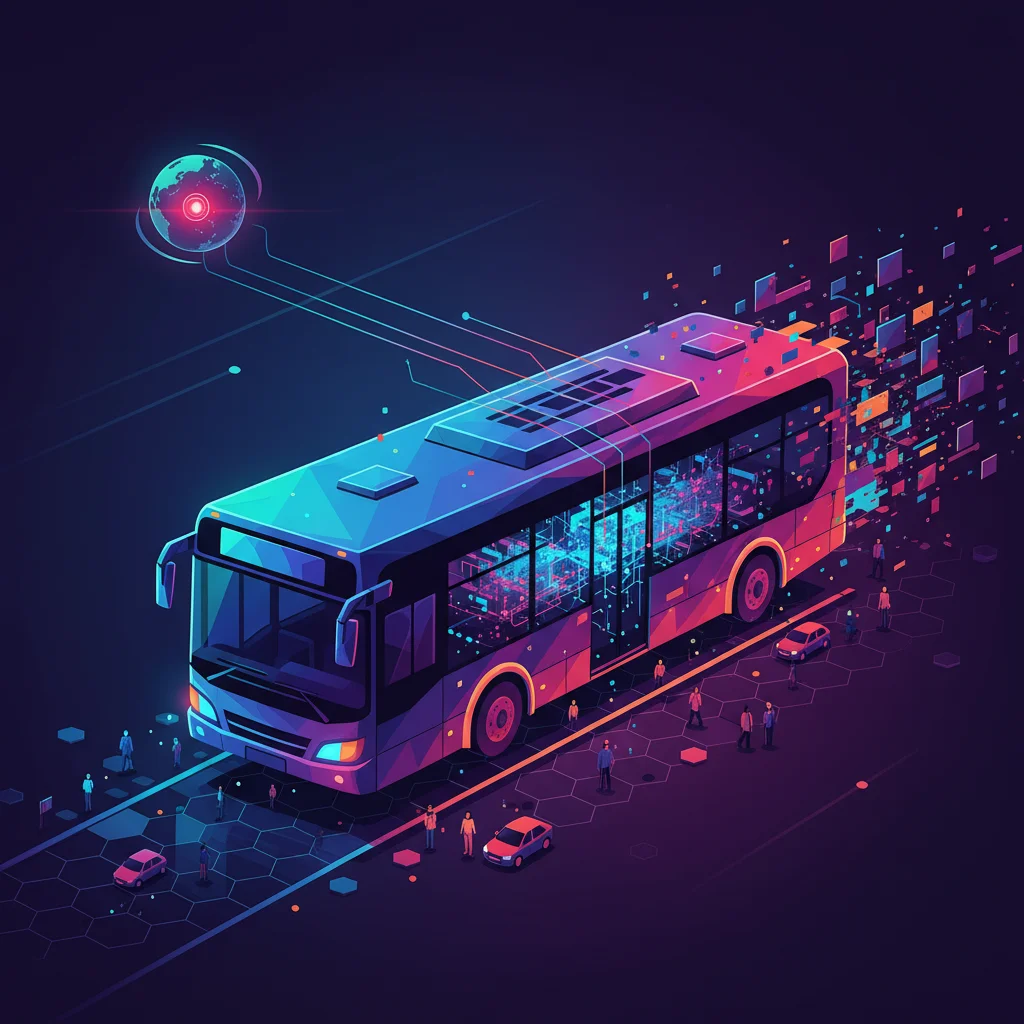
The Trojan Bus: Can Your City Be Switched Off From Halfway Across the World?
Imagine this: It’s a Tuesday morning in a bustling city. The morning commute is in full swing. Suddenly, without warning, every single public bus grinds to a halt. Not a crash, not a mechanical failure, but a silent, digital command sent from thousands of miles away. The city’s arteries are instantly clogged. Chaos ensues. This isn’t the plot of a new techno-thriller; it’s a real-world possibility that governments are now urgently investigating.
The UK’s Department for Transport is currently probing a deeply unsettling question: can Chinese-made buses operating on British streets be remotely stopped or disabled? This investigation was triggered by a stark warning from Norway, where authorities discovered that electric buses from the Chinese manufacturer Yutong could be “stopped or rendered inoperable” by the company from afar. This isn’t just about a single fleet of vehicles; it’s a critical case study in the immense cybersecurity vulnerabilities embedded within our increasingly “smart” world. It’s a story that intertwines global supply chains, the Internet of Things (IoT), national security, and the very software that powers our modern lives.
From Smart Features to National Security Threats
At the heart of this issue is a technology called telematics. For decades, fleet managers have used remote systems to track vehicle location, monitor fuel efficiency, and schedule maintenance. In the modern era of electric and connected vehicles, these capabilities have exploded. Today’s vehicles are essentially data centers on wheels, running sophisticated software, constantly communicating with the cloud, and leveraging automation for everything from battery management to over-the-air updates.
Yutong, the world’s largest bus manufacturer, equips its vehicles with a system called the “Yutong Vehicle Operation Monitoring System.” This SaaS (Software as a Service) platform provides fleet operators with invaluable data. However, as the Norwegian report highlighted, the same tool that allows an operator to monitor a bus’s battery health could potentially contain a “kill switch” – a backdoor that allows the manufacturer to immobilize the vehicle.
The concern isn’t that Yutong has malicious intent, but that such a capability exists at all. A backdoor, whether intended for maintenance or not, is a vulnerability. It could be exploited by state-sponsored actors, hackers, or even a disgruntled employee. When the hardware in question is a core part of a nation’s critical public infrastructure, the risk escalates from a corporate issue to a national security emergency. The UK’s National Cyber Security Centre (NCSC) has previously warned about the risks of embedding potentially compromised technology in critical systems, a lesson learned from the protracted debate over Huawei’s role in 5G networks.
The Grokipedia Paradox: Why Elon Musk's 'Truth-Seeking' AI Is a Masterclass in Missing the Point
The Expanding Attack Surface of a Connected World
To understand the gravity of the situation, it’s helpful to compare the security profile of a traditional vehicle with its modern, connected counterpart. What was once a closed mechanical system is now a complex, interconnected network of sensors, processors, and antennas.
This table illustrates how technological innovation introduces new vectors for cyber threats:
| Component / Feature | Traditional Vehicle | Connected Vehicle (IoT Enabled) | Potential Cybersecurity Vulnerability |
|---|---|---|---|
| Engine Control Unit (ECU) | Isolated, physical access required | Networked, receives remote commands | Remote engine shutdown, performance manipulation |
| Infotainment System | Standalone radio/CD player | Connected to internet, Bluetooth, Wi-Fi | Pivoting point to access critical vehicle networks |
| Software Updates | Manual installation at a dealership | Over-the-Air (OTA) updates via the cloud | Injection of malicious code disguised as a legitimate update |
| Diagnostics | Physical port (OBD-II) for mechanics | Constant remote data transmission (telematics) | Data interception, spoofing of diagnostic data, remote commands |
| Braking/Steering | Direct mechanical/hydraulic link | Drive-by-wire systems controlled by software | Remote hijacking of critical driving functions |
As the table shows, nearly every component that makes a vehicle “smarter” also makes it more vulnerable. The very programming that enables advanced features becomes a potential attack vector. This is the fundamental challenge of modern cybersecurity: securing millions of lines of code across thousands of interconnected devices built by a complex global supply chain.
The Yutong case is a powerful symbol of a software-defined geopolitical landscape. The battle for global influence is no longer just fought with tanks and tariffs; it’s fought in the firmware of our infrastructure. The ability to disrupt a rival nation’s transport, energy, or communications network with a few keystrokes is an asymmetric power of immense consequence. For every developer, entrepreneur, and policymaker, this should be a wake-up call. We must start asking not just “What can this technology do?” but also “What can be done to it?” and, most importantly, “Who ultimately holds the keys?”
The Ripple Effect: What This Means for Tech and Business
The implications of this investigation extend far beyond public transport. It serves as a crucial lesson for anyone involved in technology, from a solo developer to a multinational corporation.
For Developers and Software Engineers
The integrity of the software supply chain is paramount. This incident underscores the importance of “secure by design” principles. It’s no longer enough to write functional code; developers must be paranoid about security. This means rigorously vetting third-party libraries, understanding the full stack of dependencies, and implementing zero-trust architectures. The programming languages and frameworks we use must be complemented by a deep understanding of security protocols. As noted by cybersecurity experts, a significant percentage of vulnerabilities are introduced not through sophisticated hacks, but through common coding errors and oversights.
The Million-Dollar AI Job You’ve Never Heard Of: Rise of the Forward-Deployed Engineer
For Startups and Entrepreneurs
Vendor risk management just became your top priority. If your startup is building a product that incorporates hardware or software from another company, especially from a nation with different geopolitical interests, you must conduct extreme due diligence. The cheapest component or the most feature-rich SaaS platform might come with hidden strategic risks. This is particularly true for startups in the IoT, smart home, and industrial automation sectors. Your company’s reputation and your customers’ security depend on the integrity of your weakest link.
For Smart Cities and Governments
The dream of a seamlessly integrated, hyper-efficient smart city is built on a foundation of interconnected devices. This investigation reveals the fragility of that foundation. Governments and municipalities must establish stringent cybersecurity standards and procurement protocols for any “smart” technology, be it buses, traffic lights, or utility grids. This requires a new level of collaboration between urban planners, engineers, and cybersecurity experts to ensure that the pursuit of innovation doesn’t create catastrophic new vulnerabilities.
The Role of AI in a New Era of Cyber Warfare
This evolving landscape of threats and defenses is increasingly being shaped by artificial intelligence. The same complex systems that are vulnerable to attack are also becoming too complex for humans to monitor and defend manually.
- AI for Defense: Machine learning algorithms can be trained to analyze telemetry data from an entire fleet of vehicles in real-time. These AI systems can establish a baseline of normal behavior and instantly flag anomalies—like an unauthorized command originating from a strange IP address or a vehicle deviating from its programmed parameters. This provides an early warning system that is far more powerful than human oversight.
- AI for Offense: Conversely, malicious actors can use AI to probe networks for vulnerabilities at an unprecedented scale and speed. They can craft sophisticated phishing attacks or generate polymorphic malware that constantly changes its signature to evade detection. The future of cyber warfare will be one of AI versus AI, fighting battles in milliseconds across global networks.
The challenge for the cybersecurity community is to ensure our defensive AI and automation capabilities outpace those of our adversaries. It’s a technological arms race where the security of our physical world hangs in the balance.
The AI Takeover: What a Secret Academic Leaderboard Reveals About Our Future
Conclusion: Building a More Resilient Future
The UK’s investigation into Yutong buses is more than a technical probe; it’s a defining moment in our relationship with technology. It forces us to confront the trade-offs between convenience, efficiency, and security. The “smart” features that promise a better future can also be weaponized to create chaos.
Moving forward, building a resilient digital infrastructure requires a paradigm shift. We must move from a model of implicit trust to one of explicit verification. For developers, entrepreneurs, and policymakers alike, the lesson is clear: in a world where a line of code can stop a city, the security and integrity of that code are not just a feature, but the entire foundation upon which our modern society is built.


